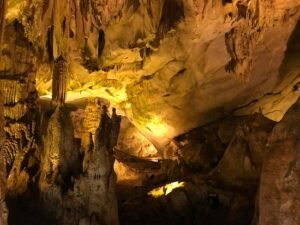Description
Dupnisa Cave (Dupnisa Mağarası) – A Hidden Gem in Kırklareli, Turkey
Introduction
Nestled in the lush forests of Kırklareli province in northwestern Turkey, Dupnisa Cave (Dupnisa Mağarası) is a captivating natural wonder that attracts adventure seekers, nature lovers, and history enthusiasts. This awe-inspiring cave system, which has existed for millions of years, offers visitors a chance to explore its mystical chambers, underground rivers, and remarkable stalactites and stalagmites. As one of the few show caves in Turkey, Dupnisa Cave provides an unforgettable experience for those looking to step into a subterranean world of natural beauty.
The Geological Marvel of Dupnisa Cave
Dupnisa Cave is a karstic formation that has been shaped by natural processes over millions of years. It is a part of the Yıldız (Istranca) Mountains, a region known for its unique geological features and dense forests. The cave stretches for approximately 2,720 meters and consists of three main sections: the Upper Cave (Kuru Mağara), the Lower Cave (Sulu Mağara), and the Girl’s Cave (Kız Mağara).
- Upper Cave (Kuru Mağara): This dry cave section is adorned with magnificent stalactites and stalagmites, which have formed over thousands of years. It remains open to tourists year-round.
- Lower Cave (Sulu Mağara): This part of the cave is home to an underground river and impressive rock formations. However, it is closed to visitors during certain months to protect the bat colonies residing inside.
- Girl’s Cave (Kız Mağara): This smaller cave is not open to the public but plays a vital role in the cave system’s ecological balance.
The Enchanting Atmosphere Inside the Cave
Upon entering Dupnisa Cave, visitors are greeted with a cool, humid atmosphere that contrasts with the warm air outside. The eerie yet mesmerizing lighting within the cave accentuates its dramatic rock formations, making it a paradise for photographers. The sound of dripping water and the occasional fluttering of bats create an otherworldly ambiance, adding to the cave’s mystique.
The most breathtaking aspect of the cave is its mesmerizing stalactites and stalagmites, which come in various shapes and sizes. Some formations have merged over time, creating grand columns that leave visitors in awe. The underground river flowing through the Lower Cave adds an extra dimension to the experience, reflecting the eerie glow of the cave lights on its calm waters.
A Refuge for Wildlife
Dupnisa Cave is not just a geological wonder; it is also a critical habitat for diverse wildlife. The cave serves as a sanctuary for bats, with approximately 16 different bat species residing within its dark chambers. During the winter months, the Lower Cave is closed to protect these fascinating nocturnal creatures as they hibernate. The surrounding forests also support a variety of animals, including wild boars, foxes, and different bird species, making the area a haven for nature enthusiasts.
The Cultural and Historical Significance
Although Dupnisa Cave is primarily known for its natural beauty, the region surrounding the cave has historical significance as well. The Yıldız Mountains have been home to various civilizations, including the Thracians, Romans, Byzantines, and Ottomans. While there is no confirmed evidence of human habitation within the cave itself, it is believed that ancient people may have sought shelter in its depths during different historical periods.
How to Get to Dupnisa Cave
Dupnisa Cave is located in the Demirköy district of Kırklareli province, approximately 230 km from Istanbul and 58 km from Kırklareli city center. The journey to the cave is a scenic experience in itself, as visitors pass through dense forests and picturesque landscapes.
- By Car: The most convenient way to reach Dupnisa Cave is by car. From Istanbul, travelers can take the E80 highway toward Kırklareli and then follow the signs to Demirköy and Sarpdere village, which is the closest settlement to the cave.
- By Public Transport: While there are no direct buses to the cave, visitors can take a bus to Kırklareli and then hire a taxi or rent a car to reach the site.
Best Time to Visit
The best time to visit Dupnisa Cave is between April and October, when the weather is pleasant and the cave is fully accessible. During the winter months, the Lower Cave is closed to protect the bat population. The surrounding forests are particularly beautiful in the spring and autumn, with vibrant foliage adding to the scenic charm of the area.
What to Expect and Travel Tips
- Wear comfortable clothing and sturdy shoes: The cave floor can be slippery, so proper footwear is recommended.
- Bring a flashlight: While the cave is illuminated, having an extra light source can enhance your exploration experience.
- Respect the environment: Avoid touching the cave formations, as this can cause long-term damage.
- Check for seasonal closures: Since part of the cave is closed during certain months, it’s best to check in advance before planning a visit.
Nearby Attractions
For those looking to explore more of Kırklareli after visiting Dupnisa Cave, here are some nearby attractions worth checking out:
- Igneada Longoz Forests National Park: A unique ecosystem with flooded forests, rich biodiversity, and scenic hiking trails.
- Kıyıköy: A charming coastal town with a mix of Byzantine and Ottoman history.
- Demirköy Foundry: A historical iron foundry from the Ottoman period.
Conclusion
Dupnisa Cave is an extraordinary destination for nature lovers, adventure enthusiasts, and those seeking a unique experience in Turkey. With its breathtaking rock formations, underground rivers, and thriving wildlife, the cave provides an unparalleled opportunity to explore the hidden wonders of Kırklareli. Whether you're a seasoned traveler or a first-time visitor, this captivating cave will leave you with unforgettable memories of Turkey's natural beauty.
Location
-
Dupnisa mağarası




